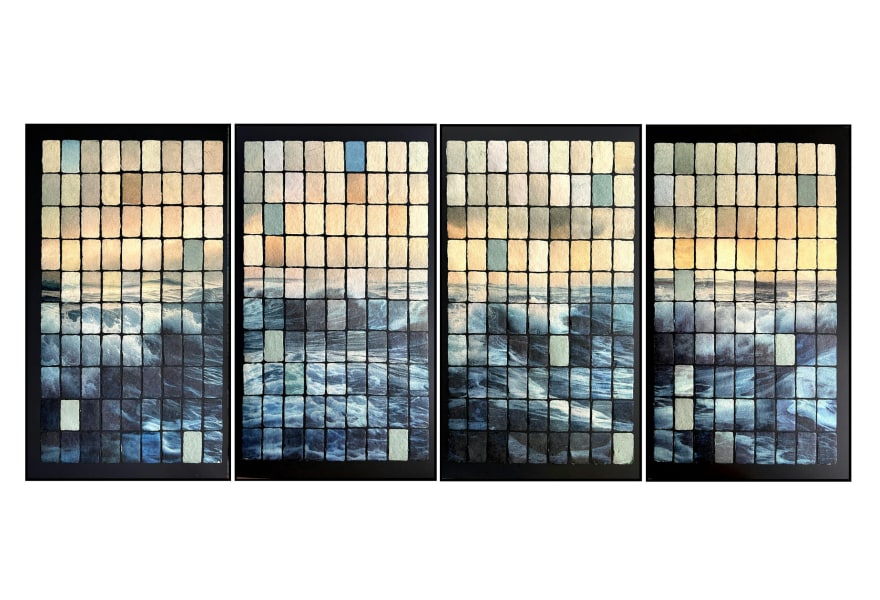03 september 2024, Flor Linckens
Preview Unseen: Joost Vandebrug: The Interweaving of Matter and Time
At Unseen, Bildhalle will showcase a solo by Dutch artist Joost Vandebrug. His art explores the boundaries of the photographic medium, characterised by his meticulous attention to the material aspects of photography and his unconventional printing techniques. Vandebrug's thematic interests encompass the natural, the vulnerable, the ephemeral, the poetic, the slow, and the magic of the everyday.
Vandebrug's practice is distinguished by extensive material research, embracing imperfections as part of the creative process. He prints his works on meticulously crafted handmade Japanese washi paper, Nepali paper or baryta paper. When Vandebrug mentioned on social media that he had printed on 5gsm washi paper (5 grams per square meter), a follower remarked on the challenge of printing on such thin, almost transparent material. Vandebrug replied, "As thin as the wings of a butterfly!”
The photographer utilises various historical printing techniques, including pigment transfer and silver gelatin prints. These methods produce fragile and unique objects, in which irregularities in the paper and traces of the process remain visible. Vandebrug considers these 'accidents' and minor damages crucial to his work, as they expose the mechanics of the process and imbue the final product with a kind of vibrancy. Moreover, these imperfections frequently echo the themes of his work, such as sensitivity and vulnerability.

Joost Vandebrug, 24-N-XI, courtesy Bildhalle
Vandebrug's fascination with the Danube is a recurring theme in his work. He views the river as a symbol of life, purity, and fertility, and as a metaphor for the irreversible passage of time. To him, the river's constant flow through ten countries embodies the continuous transformation of life and culture. Vandebrug connects water and reflection with peace, happiness, healing, and purifying thoughts. While water typically mirrors images and light, much like photography, a flowing river disrupts this reflection, a detail that captivates him. Once home, he works with the 'souvenirs' he collected along the way: stones, leaves, wilted flowers, and grains of sand, which he then photographs through a microscope. In other photographs, he immortalises objects that were destined for a transient existence, such as flowers or leaves.

Joost Vandebrug, N-E-I, courtesy Bildhalle
Vandebrug also draws inspiration from other sources, including a dark period in his life. For his earlier series "Exhilarating", the photographer delved into themes of light and hope. These works emerged from a period marked by fear and isolation, during which he confined himself to an old chaise longue by a window in his house in France. Each day became a mirror of the last. Every piece in the "Exhilarating" series consists of a hundred small handmade paper cards depicting overwhelming mountain landscapes at twilight. Through these diagonally placed images, Vandebrug visualises his gradual return to light and positivity. By choosing the twilight in this series, light and dark are given equal weight and become equally important. And by sharing a hundred moments at a time, he emphasises the necessity of occasionally zooming out to grasp the bigger picture. These pieces symbolise a transitional period, and by securing them with pins instead of tape or glue, they also convey a sense of vulnerability.

Joost Vandebrug,24-N-VII, courtesy Bildhalle
One of Vandebrug's notable recent projects is 'Pillow Book,' inspired by the concept of a pillow book: a personal diary filled with reflections, poems, anecdotes and observations, traditionally used in ancient Japan to document daily life and thoughts. Vandebrug interprets this form more loosely, exploring connections between past and present and the ways memories and experiences are distorted by time. Each piece in this series consists of more than a hundred monotypes on handmade mulberry paper cards. These compositions blend authentic and distorted elements, reflecting the multifaceted nature of memories.
In the Unbound section at Unseen, Joost Vandebrug will present an immersive video installation based on his work "You can never step in the same river twice". The panoramic display features eight vertically positioned TV screens displaying eight unique and synchronised seascapes with aligned horizons. The installation delves into the philosophical notion of flux and impermanence, drawing parallels between the dynamic nature of the water and the ever-changing aspects of human existence. Each video captures a distinct moment in time, reflecting the infinite variability of rivers, tides and atmospheres.
Vandebrug studied at the Gerrit Rietveld Academy in Amsterdam. His artistic practice spans photography and film. His documentary film and long-term project ‘Bruce Lee and the Outlaw’ was screened at over fifty film festivals, garnering multiple awards and receiving a five-star review from The Guardian. Vandebrug's work has been exhibited at Foam Photography Museum Amsterdam and FOMU (Photo Museum Antwerp). Additionally, he has shot campaigns for notable publications and brands, such as i-D, L'uomo Vogue, Nike, Superdry and Dsquared2.
